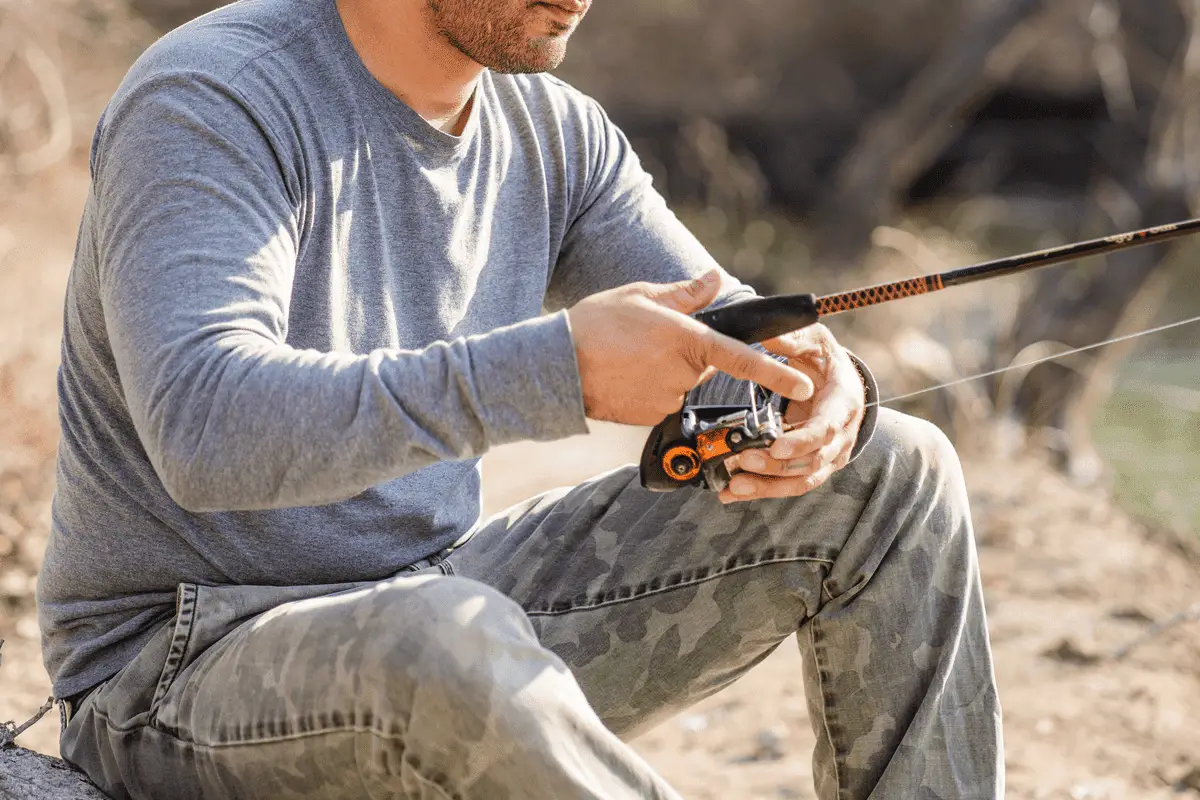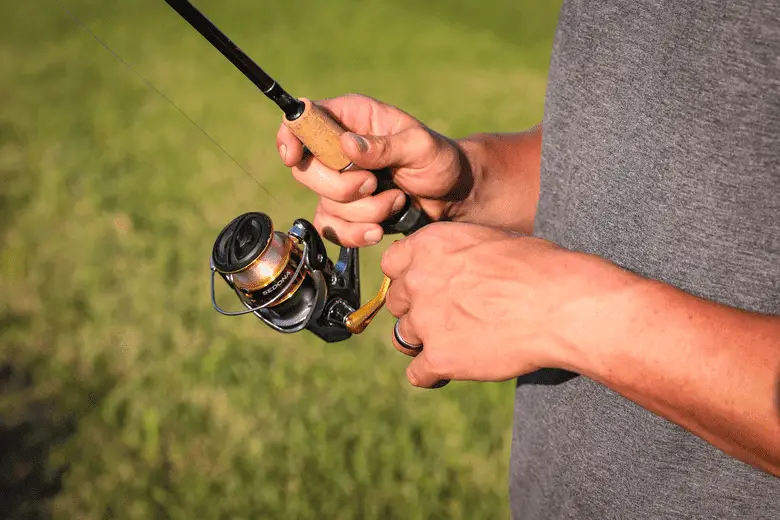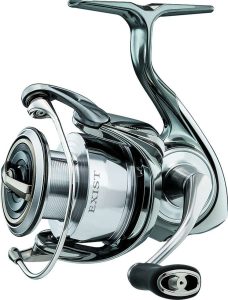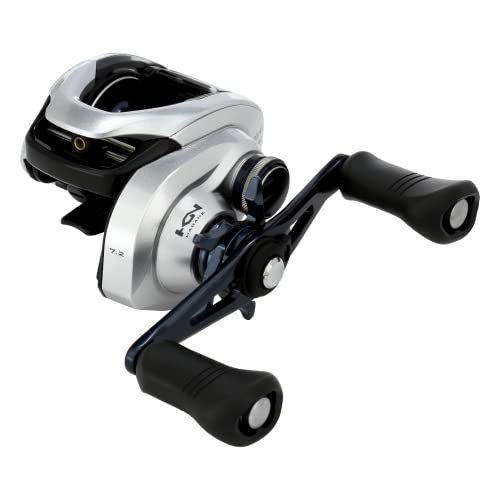



We hope you love the products we recommend. Just so you know, OnTrack Fishing may earn an affiliate commission from the links on this page, at no extra cost to you.
I’ve cast plenty of cranks with rod and reel combos. I’m a surf and rock specialist – a salty.
Crankbaits are special.
If you have limited cranking experience, you’re always best to match your reel to your crank.
The great news for you is that there’s many awesome crank reels for all budgets and cranking styles.
I’ve selected 5 reels, baitcaster and spinning reels – yes spin, and reviewed them here.
I ran my selections by a crank-master buddy of mine. I know it hurt him to say – but he thought my selections were perfect – after making me justify each selection…
I’ve listed them below with links to prices as well as adding a handy crank bait reel buyers guide.
Before we get into it, let me preface this feature with a dose of reality. What you must know upfront is that cranking is awesome fun.
I would encourage every angler to try it out, and see why so many anglers become crank fanatics.
Most importantly, you don’t need any special gear to extract a serviceable performance from a crank.
Don’t dismiss cranking because you don’t have the perfect reel or rod, or the budget to kit up with the best. Get out and crank with what you have in your kit.
However, if your fishing budget allows, grab yourself a reel from the list below, leaving enough money to purchase a fist full of various cranks.
Getting the right reel will help you develop technique and increase your strike rate, making cranking easier and more enjoyable wherever you cast.
This list is your quick reference guide with links to prices. I encourage you to read to the end, it’ll help you choose.
Last update on 2023-12-20 / Affiliate links / Images from Amazon Product Advertising API
If somebody tells you that you need a baitcaster to crank properly, don’t believe them. It’s not true.
The only exception might be for tournament pros, where seconds impact your prize money. Casting rates are generally faster with baitcaster rigs in the hands of pros.
For the average angler, dedicated bass hunter, lure angler, or crank angler, the best results come from using the reel type with which you are most proficient – and most comfortable.
Cranking is awesome with spin or baitcaster – especially if you have the right one for your crank.
This Daiwa Exist is the top-of-the-top shelf choice for the angler with a lot of cash who loves quality in spinning reels.
This is an aspirational reel in anybody’s language, and so is the price.
But the new Exist series is phenomenal in every way, from looks, feel, performance, and durability.
TheExist G LT 2500 critical cranking features include its 6.2 ratio and retrieve rate of 34 inches. It weighs in at only 165 grams.
It’s suitable for all anglers as it’s so easy to use.
The ratio is right in the middle and works well for all types of cranking. You can wind fast or slow with this reel, without disturbing its superb balance.
You can burn it, Jerk it, yo-yo, and stop and go. Fish lipless or any bill configuration your preferred depth demands.
Pros
Cons
Key Features at a Glance
I love the ergonomics of the Shimano Tranx 200. What’s more, it’s incredibly strong yet compact. Depending on the line class you choose, you can cast a wide variety of crankbait weights.
I like the 7.2 ratio because it’s great for those who prefer speed, yet it works beautifully when cranked slowly. It never labors when cranked slowly.
Again, versatility wins the day. You have access to a wide range of crankbaits, and you can work them all at peak, with this ergonomic masterpiece.
The Tranx isn’t cheap and is classed as a premium baitcaster reel. In my opinion, it’s worth the money.
I might get some arguments about its ergonomics because it’s a little heavier than similar reels.
However, I’m a big fan of high precision with a backbone to take the knocks.
I recommend the Tranx 200 for the trophy fish hunter, seeking big bass, big walleye, muskies, and pike.
It’s a big crank and big fish reel.
Pros
Cons
Key Features at a Glance
This is the best go-to crankbait baitcaster going. It’s ideal for the beginner and the season tournament pro.
There’s a great range of ratios, but the 8.5 would be my bass tournament pro baitcaster choice.
Traditionally, crank anglers go with slow ratios close to 5. But you’ll see tournament pros going with speed for efficiency.
Keep in mind that it’s much easier to reduce your retrieve speed than it is to wind faster.
Winding a slow reel faster causes fatigue and can compromise lure action.
No one would be surprised at the presence of the Shimano Curado, on the contrary, if it wasn’t featured here, people would wonder why.
I love the Curado for land-based cranking too, where big casting distance is essential. Its casting manners are superb.
In the right hands, it casts prodigious distances.
Pros
Cons
Key Features at a Glance
Many new crankers insist on buying a baitcaster only to be stopped in their tracks by high price points.
The Pflueger President XT Low Profile Baitcaster bypasses the money game delivering a quality performance, ideal for cranking on a budget.
It’s not without its small issues – grip and handle could be more user-friendly in terms of ergonomics, but it’s a very small gripe.
The build quality is surprisingly good, and while it’s a bit fast to be an excellent all-rounder for beginners, it’s not too fast 7.3.
Retrieving the XT slowly is also a surprise. It holds its own against the high-end models in this regard.
Casting delivers good results with a broad range of crank weights. It took me a little while to sort out settings for maximizing lighter cranks, but I got it eventually.
Interestingly, after trying a bunch of techniques, I spooled light and worked a round bill to 15 feet with great success.
I used the same crank, thinking the XT would be cool for trolling. I didn’t get anything, it wasn’t the aim, I just wanted to feel the setup – it worked particularly well.
Pros
Cons
Key Features at a Glance
I don’t know why these spinning reels get overlooked and why I don’t own one. At this price point, light spin doesn’t get any better.
The Roxani’s robust yet lightweight construction ensures both resilience and agility, making it suitable for various fishing applications – It’s a great crankbait reel.
The reel’s gear system provides exceptional smoothness during retrieves, enhancing control and sensitivity.
This is exactly what you want when cranking – plenty of feel, and plenty of feedback from the business end of the fishing line.
The 6.2 ratio is ideal for crank versatility. With 34.3 inches of retrieve, you can go fast if needs be or slow it down to a snail’s pace without getting loops on your spool.
This would be my go-to crankers for panfish, and the more commonly caught sizes of small and largemouth.
If I owned one, I think it would become my smallmouth go-to. I liked it spooled with mono and braid – 6-pound mono was ideal.
Maybe not the best for larger cranks and serious depth, but it’s ideal to 10 feet with all crank types, land-based or afloat, with whatever bill shape you wish.
Pros
Cons
Key Features at a Glance
When we look for a crankbait reel, we look at construction materials, drag capacity, spool capacity, and a range of features.
While we do this with crankbait reels, there are two core things we consider. 1, is gear ratio or speed, and the other is feel, or ergonomics.
When it comes to crankbaits, gear ratio / retrieve rates have been the most critical factor. This is pretty tangible and easy to understand, or at least it was.
Modern reels have changed this somewhat.
While ratios between 5.5 and 6.5 are still popular, many crankers are going with the high speeds, 7s, and 8s of modern baitcasters.
The question is why?
By and large, it’s a lot easier to crank a fast reel slowly than it is to crank a slow reel at pace.
Modern reels are so smooth and so well-balanced, that it’s quite easy to reduce your winding pace without compromising performance.
These days, you’ll see a lot of tournament pros selecting speedy reels to increase their casting cycle rates – time matters to pro anglers.
If in doubt, go with tradition and you can’t go wrong. Slower ratios make it easier to control the action of the crankbait.
We want our cranks to bump, collide, and disturb. It requires a reasonably high level of control to achieve this and maintain consistent peak lure action.
While they say working crankbaits is easy, which it is to a degree, getting the most from your crank requires experience and feel.
It’s easier to achieve a great feel on a slower retrieve, which is easily achieved on a slower ratio.
This is where things get subjective. That which works for one cranker feels terrible to another.
Crankers want to know what their lure is doing. Often, we’re working them in horrible snag-ridden places, banging them up against the structure.
While the nose-down position of a crank helps to keep the trebles from foul hooking sunken boats, it’s not foolproof.
We want a responsive reel, so we can react to the feedback passed through the line, through the reel to our hand.
We need reel ergonomics that suit our physique, and our technique to make reaction times faster, and more efficient.
Feel, and ergonomics sit alongside gear ratios as being the most important aspects of selecting the right crankbait reel.

To help us understand this a little better, let’s revisit crankbait types
These lures have a smaller bill or lip and are designed to run at shallower depths, typically from the water’s surface to around six feet.
They excel in targeting fish holding near the shorelines, submerged vegetation, or over shallow structures.
Their ability to work in tight spaces without snagging makes them ideal for exploring cover-rich areas.
Featuring a moderately sized lip, these crankbaits dive to depths between 6 to 12 feet.
They strike a balance between versatility and depth coverage, making them suitable for a wide range of water conditions.
Anglers often use them to explore mid-depth structures and transition zones.
With larger bills, these crankbaits reach depths of 20 feet or more.
They’re invaluable when fish are holding in deeper structures or during periods of cooler water when fish retreat to deeper zones.
Anglers favor them for targeting fish in deep reservoirs, river channels, or offshore structures.
These baits lack the traditional diving lip, instead relying on their shape and weight distribution to create vibrations and erratic movements.
They can be versatile, covering various depths depending on retrieval speed.
They work well in vegetation-filled areas and open water, drawing reaction strikes from predatory fish.
Lipless is probably the reason many anglers are using reels of all speeds with great success.
The lipless is particularly versatile, responding well to a variety of retrieve speeds.

Most experienced crankbait anglers will know exactly what they’re looking for, matching rods to reel themselves – rarely buying a proprietary combo.
If you’re completely new to cranking, combos can be effective, but will, by and large, provide traditional cranking attributes such as slower ratios.
My recommendation is to select a rod 6 to 8 feet, depending on where you are fishing, and look for a slower action.
You need a rod that bends in the middle when moderate pressure is applied. Casting is better and easier, and it is far more forgiving on the strike.
You are far less likely to pull the hooks from the mouth of your target with a slower action rod.
Carbon rods are brilliant, – so light and responsive, with a greater variety of options. Full glass is far too heavy and hard to find.
Composite is great, especially for beginners, however, the range isn’t as good as you’ll find in full carbon.
Select a power of light and below. Light medium might be OK with big cranks, chasing trophy fish. Make sure you check the casting specs first.
Above all, the rod and reel must balance. This is an article unto itself. The reel must match the rod to achieve performance casting, fight, and feel.
If you don’t understand balance, go for a proprietary combo, research online, or head down to your local tackle shop so you can see and feel a balanced outfit.
What Speed Reel Is Best For Crankbaits?
For crankbaits, a lower-speed reel with a gear ratio of around 5.4:1 to 6.4:1 is ideal. This slower retrieve rate allows for greater control, feel, and consistency.
However, these days, many performance reels with high-speed ratios allow you to crank very slowly and still maintain control, feel, and feedback.
What Power And Action Is The Best For Crankbaits?
The best rod power and action for crankbaits are typically light medium and lower, with a slower to moderate action.
A mid-power rod provides the right balance of flexibility and backbone necessary for effectively fishing with crankbaits across various depths and cover types.
The moderate to moderate-slow action allows the rod to bend from the midsection. This action absorbs shock making your rig more forgiving when hooked up.
This action can be beneficial for casting accuracy and control when practiced a little.
Preferences will vary based on specific fishing conditions and individual styles. Some anglers might opt for a medium-heavy power rod for larger crankbaits and bigger fish.
Many will go a little heavier when the cover is heavy. We cast our cranks close to danger. It gets expensive when we can’t get them back.
What Is The Best Fishing Reel For Squarebill Crankbaits?
The best fishing reel for Squarebill crankbaits is typically a low gear ratio baitcasting reel, preferably in the range of 5.4:1 to 6.4:1.
This lower gear ratio provides the necessary torque and control required for effectively fishing Squarebill crankbaits.
Squarebill crankbaits are designed to deflect off cover and have a wider wobble. This makes them effective in shallow water around structure.
What Is The Best Crankbait Fishing Reel For Lipless Crankbaits?
For lipless crankbaits, you can go with any ratio you choose. However, I like 6.5 to 7.5 in a high-end reel.
This speed allows for a greater variety of speeds with little effort, regardless of the depth or crankbait size.
If you’re fishing lipless, by and large, you have a lot of scope for ratios and speed. My bottom line for Lipless is a very smooth feel and responsiveness.
Subscribe today to get the latest Hacks and to be notified of the Best Prices on Angling Equipment










